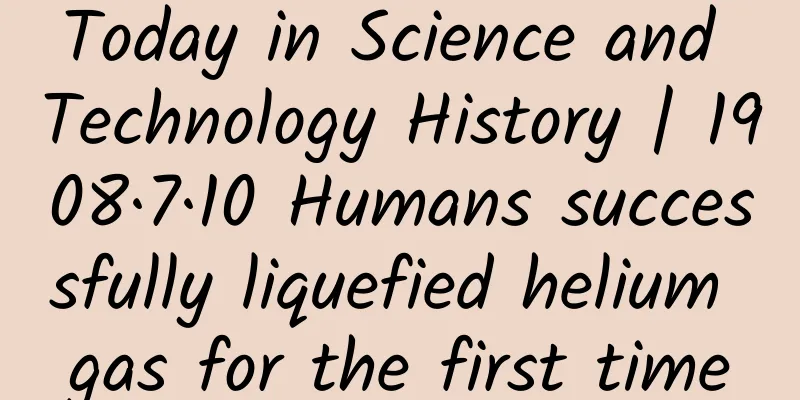Today in Science and Technology History | 1908·7·10 Humans successfully liquefied helium gas for the first time

|
On July 10, 1908, the discoverer of superconductivity, Dutch physicist Kamerlingh Onnes, successfully liquefied helium for the first time, marking an important breakthrough in science. At that time, humans had been unable to liquefy helium because its gaseous state was extremely stable and could remain non-condensing at any temperature, making its liquefaction a major challenge for scientists. After a long period of unremitting efforts, Onnes finally found the key method to solve the problem of helium liquefaction. He used a new refrigeration technology to place helium in a low-temperature environment and apply high pressure, and finally successfully liquefied helium. This groundbreaking experiment won him the 1913 Nobel Prize in Physics and opened a new era of liquefied helium research. ●Solve the problem of helium liquefaction In 1882, 29-year-old Kamerlingh Onnes was appointed professor of physics and director of the physics laboratory at Leiden University in the Netherlands. At that time, global physics was in a period of transition, and people paid more and more attention to physical experiments. After Onnes became the director of the physics laboratory at Leiden University, he decided to focus on the study of low-temperature physics. On July 10, 1908, Kamerlingh Onnes and his colleagues, after careful preparation and collective efforts, finally liquefied helium, marking the debut of "big science" in the 20th century and its initial success. In order to do this experiment well, Onnes made extremely detailed preparations. He made a theoretical estimate of the liquefaction temperature of helium in advance, which was expected to be between 5K and 6K. There was a large reserve of helium and an adequate supply. Liquid hydrogen was homemade. The day before the experiment, they prepared 75 liters of liquid air for use. At about 5 a.m., 20 liters of liquid hydrogen were ready and gradually poured into the helium liquefier. Precooling with liquid hydrogen requires extreme caution, as even a small amount of air mixed into the system will ruin all the previous efforts. At 1:30 pm, the helium liquefier was fully filled and began to circulate. The thermostat at the center of the liquefier began to reach a temperature never reached before, and this temperature could only be indicated by the helium thermometer. However, the indicator did not change for a long time. People adjusted the pressure, changed the expansion piston, and used various possible measures to promote the operation of the liquefier, but the thermometer seemed to be moving and it was difficult to make a judgment. At this time, the liquid hydrogen was almost exhausted, and there was still no sign of liquid helium. At 7:30 in the evening, seeing that the experiment was about to fail, a professor who had come to watch suggested to Kamerlingh Onnes that perhaps the helium in the helium thermometer itself had also liquefied. Would it be possible to illuminate the container from below to see what was going on? Onneston was enlightened and immediately followed the instructions. The result surprised him. It turned out that the central thermostat was almost full of liquid, and the reflection of light allowed people to see the liquid surface. This time, Kamerlingh Onnes obtained a total of 60 ml of liquid helium, reaching a low temperature of 4.3K, thus finally eliminating the absolute boundary between gas and liquid. This made mankind take a crucial step in the journey towards absolute zero. ●Discoverer of superconductivity The electrical resistance of metals was an important research topic for Onnes. At that time, there were different opinions on how the resistance of metals changed near absolute zero. Some people believed that the resistance of pure metals should gradually decrease as the temperature decreased, and eventually disappear at absolute zero. Onnes initially believed in another view proposed by Kelvin in 1902, that is, as the temperature decreases, the resistance of metals will become infinite after reaching a minimum value due to the condensation of electrons on metal atoms. Onnes had mastered the technology of liquefied helium, so he had the conditions to study this problem experimentally. In February 1911, he measured the resistance of gold and platinum at liquid helium temperature and found that below 4.3K, the resistance of platinum remained a constant, rather than reaching a minimum value and then increasing. Therefore, he changed his original view and believed that the resistance of pure platinum should disappear at liquid helium temperature. In order to test his view, Onnes chose mercury as the experimental object because mercury is easier to purify than other metals. The experimental results showed an unexpected and strange phenomenon: the resistance of mercury suddenly disappeared at about 4.2K. This extraordinary discovery not only indicates that the power generation efficiency can be greatly improved in the power industry, but also opens up a broad space for people to use this superconductivity to manufacture superconducting motors, superconducting magnets and superconducting cables. From April to November 1911, Onnes reported his experimental results in detail in three consecutive papers. In 1913, Onnes discovered that tin and lead also have superconductivity like mercury, and impure mercury also has superconductivity. For his research on the low-temperature properties of matter and the preparation of liquid helium, Onnes was awarded the 1913 Nobel Prize in Physics. Due to Onnes' outstanding leadership and management of the Leiden University Physics Laboratory, the laboratory became the center of low-temperature research in the world in the early 20th century. ●Strategic rare gas resources The realization of liquefied helium had a huge impact on the scientific community at the time. The emergence of liquid helium allowed researchers to gain a deeper understanding of the properties and characteristics of helium, which in turn promoted the study of the liquefaction of other substances. Secondly, the technology and equipment used in the preparation of liquefied helium also provided researchers with more experimental means to carry out more extensive scientific research. However, the significance of liquefied helium research goes far beyond this. As an important industrial raw material and energy source, the breakthrough of helium liquefaction technology will also bring huge benefits to the industry. Liquefied helium can greatly reduce its volume, making it easier to store and transport, and providing convenience for industrial production and scientific experiments. Moreover, liquefied helium has a wide range of applications. Helium has important applications in the aerospace field, and human exploration of the universe is inseparable from the selfless contribution of helium. For example, in the launch of liquid fuel spacecraft, helium is an irreplaceable cleaning agent and leak detection agent for fuel tanks and pipeline systems, as well as a booster gas and coolant for fuel loading, etc. When cleaning pressurized liquid hydrogen tanks and pipeline systems, in the low temperature environment of liquid hydrogen, any other gas (such as nitrogen or argon) will freeze and mix with liquid hydrogen to block pipes and valves, while helium is the only inert substance with a liquefaction temperature far lower than hydrogen, so it can operate in a liquid hydrogen environment. Helium also plays an important role in deep-sea diving, providing protection for deep-sea exploration. For example, divers usually use a helium-oxygen mixture for deep-sea diving (submarine). This mixture of helium instead of nitrogen can reduce the danger and discomfort caused by nitrogen dissolving into the diver's blood, as the solubility of helium in the blood is significantly lower than that of nitrogen, and greatly reduces the risk of bubbles accumulating in the blood vessels due to a sudden drop in pressure when the diver returns to the surface. Helium has important applications in the medical field and is known as a "life-saving" gas. For example, in technologies such as nuclear magnetic resonance (NMR) and magnetic resonance imaging (MRI), the core of the MRI is a superconducting magnet, which cannot operate stably without liquid helium and cannot guarantee high-resolution imaging; in the treatment of respiratory diseases, helium can increase the transmission rate of oxygen in the respiratory system and relieve the symptoms of respiratory diseases; in addition, helium can also be used for the treatment and prevention of neurological diseases. The information age is also inseparable from the protection of helium. Helium has broad application prospects in quantum computers. In order to keep the temperature of quantum bits at around absolute zero, quantum computers need to be cooled with liquid helium. Without helium, quantum computers will not be able to operate stably. Comprehensively from "Popular Science and Culture of Land and Resources" and "Popular Science China" |
<<: Danger! Don’t do this when your roof is moldy
>>: What diseases are prone to occur in hot and humid weather? Here is the authoritative answer!
Recommend
The strongest sandstorm this year is coming, why can't the shelterbelt forest stop it?
When I woke up one night, my glass windows were c...
Cameras also need to be "both inside and outside" Tesla monitors human-machine interaction
Recently, according to the electrek website, at t...
Prepare for 618! The latest Baidu search & information flow advertising guide!
The biggest e-commerce promotion in the first hal...
Liu Guosheng's Sanyuan Yanggong Fengshui Guangzhou Training Course 2017
Feng Shui, which originated in ancient times, is ...
Easier to bully than flies and mosquitoes! Why can't we kill all the "little moths" in the toilet?
Have you ever had this experience: squatting in t...
Dameiyang Art: Learn Sketching from scratch, from elementary to advanced
Course Catalog: ├──Beginner's sketch | ├──Lec...
Hu Q&A: How to measure a temperature of 100 million degrees?
How to measure a temperature of 100 million degre...
How to promote a website? Detailed explanation of website promotion!
Promotion goals Compared with the complete Intern...
If this kind of sound appears in the ears, does it mean that you are not far from becoming deaf?
Reviewer of this article: Chen Haixu, Deputy Dire...
Should wisdom teeth be removed? If it doesn't hurt, you can just leave it alone? Here are all the answers about wisdom teeth
Most people don’t know they have wisdom teeth. So...
Kunming Baidu Ai Procurement customer service phone number, how much does Baidu Ai Procurement promotion cost?
Baidu Aicaigou is a B2B e-commerce platform that ...
How to protect your knees when running?
People often tell me that their knees hurt after ...
Don’t forget that the main feature of autumn and winter weather is fog! Don’t just rush to travel as early as possible
There are actually two main types of weather in C...
Google re-emphasizes upgrade policy, most Android devices continue to be excluded from updates
[[127122]] Due to the large amount of code that n...
How to implement a product from 0 to 1 and increase user growth?
The goal of this series is to help product novice...









